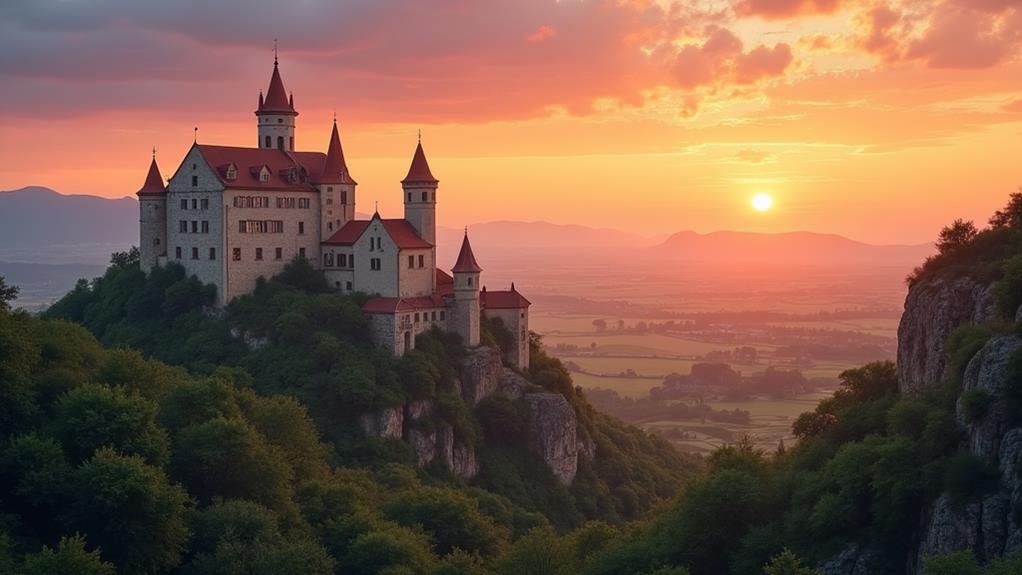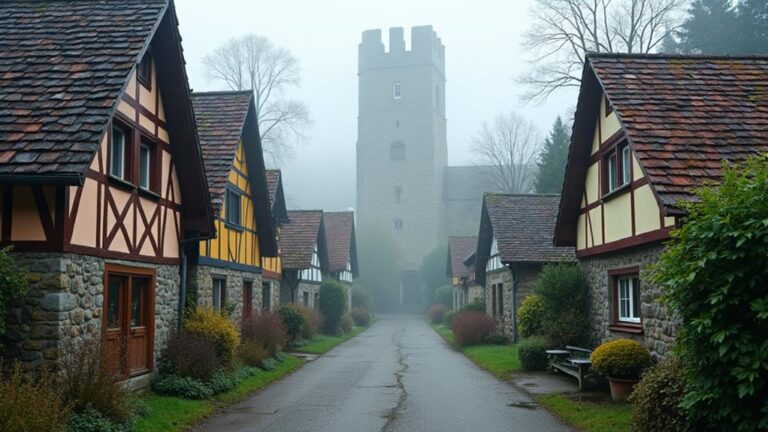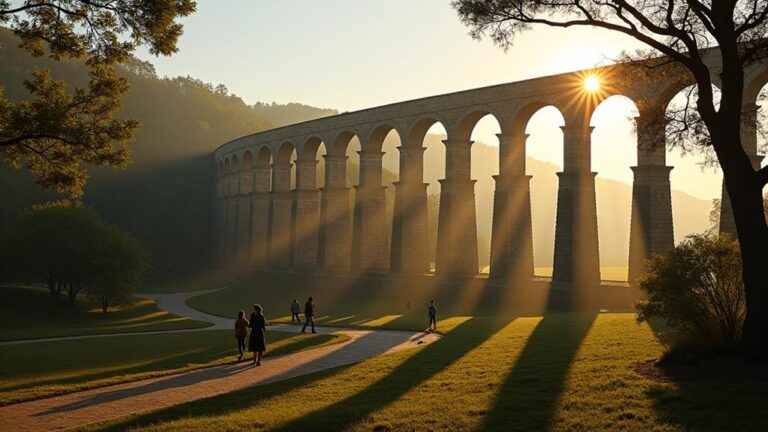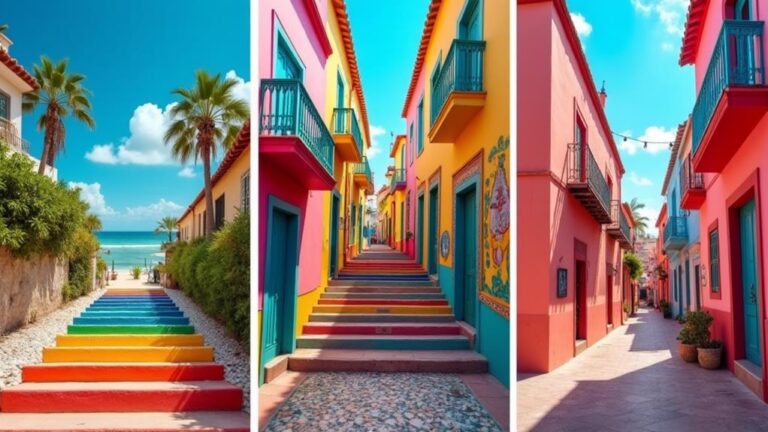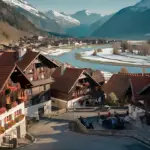As you explore Spain, you'll discover a wealth of stunning castles that reflect the country's complex history and cultural diversity. Each region boasts its own unique architectural gems, from the Moorish influences of the south to the Romanesque styles of the north. You'll find yourself drawn to the grandeur of medieval fortresses and the elegance of Renaissance palaces. But which of these incredible structures takes the title of most beautiful? From the fairytale-like Alcázar of Segovia to the breathtaking La Alhambra, there are many contenders – but can just one castle stand out from the rest?
Contents
Key Takeaways
- Alcázar of Segovia Castle stands out with its distinctive fairytale-like shape and stunning stained-glass windows.
- Loarre Castle in Aragon boasts Romanesque architecture and imposing stone walls, showcasing its defensive prowess.
- Cordoba's Alcázar Fortress features a unique blend of Moorish influence and Roman roots, creating an enchanting atmosphere.
- Castell De Bellver in Mallorca showcases a unique circular architecture, blending Gothic and Romanesque styles.
- La Alhambra in Granada is a legacy to the region's Islamic heritage, with intricate stone carvings, delicate arches, and serene gardens.
Alcázar of Segovia Castle
Located in the heart of Segovia, the Alcázar of Segovia Castle stands majestically, a monument to Spain's rich medieval past.
As you walk towards the castle, you can't help but be drawn to its unique blend of Romanesque influence and Gothic architecture.
The castle's distinctive shape, with its turrets and pointed spires, is reminiscent of a fairytale.
You'll be impressed by the castle's grandeur as you step inside.
The interior is just as impressive as the exterior, with intricate stone carvings, ornate tapestries, and stunning stained-glass windows.
The Alcázar has played host to many significant events throughout history, including royal weddings.
In fact, it's said to be the inspiration behind Walt Disney's Cinderella Castle.
As you explore the castle, you'll discover its rich history and the many legends that surround it.
From its origins as a Roman fortress to its role as a royal residence, the Alcázar of Segovia Castle is a must-visit destination for anyone interested in history, architecture, or simply experiencing the magic of Spain's medieval past.
With its unique blend of styles and rich history, it's no wonder this castle is considered one of the most beautiful in Spain.
Cordoba's Alcázar Fortress
As you wander through the historic city of Cordoba, the majestic Alcázar Fortress rises above the streets, its ancient stones bearing witness to the city's rich Moorish and Christian heritage. The fortress's strategic location on the Guadalquivir River reflects its Roman roots, dating back to the 1st century BC. Over the centuries, the site was transformed and expanded by the Moors, introducing their distinct architectural style.
| Architectural Features | Description |
|---|---|
| Roman Walls | Original foundations from 1st century BC |
| Moorish Gardens | Lush and tranquil oasis with fountains |
| Alcázar Palace | 14th-century palace showcasing Moorish influence |
| Mosaic Decorations | Intricate patterns and designs adorning the walls |
| Battlements | Defensible walls with ornate towers |
The Alcázar Fortress showcases a unique blend of Moorish influence and Roman roots, creating an enchanting atmosphere that invites exploration. As you walk through the fortress's gardens and halls, you'll discover the rich history of Cordoba, tracing the evolution of the city's architectural style from Roman to Moorish. The Alcázar Fortress stands as a legacy to the city's enduring cultural heritage.
La Alhambra in Granada
Beyond Cordoba's historic streets, another iconic Moorish masterpiece awaits: La Alhambra in Granada.
As you step into this breathtaking palace, you're surrounded by the rich Moorish influence that has shaped the city's architecture. La Alhambra's majestic presence is a legacy to the region's Islamic heritage, with intricate stone carvings, delicate arches, and serene gardens that evoke the tranquility of a bygone era.
The palace's Islamic architecture is a marvel of precision and craftsmanship, with every detail meticulously designed to create an atmosphere of opulence and refinement.
The complex's Generalife gardens are a particular highlight, featuring picturesque courtyards, reflecting pools, and lush vegetation that provide a serene escape from the city's bustling streets.
As you explore La Alhambra, you'll discover the intricate history and culture that have shaped this stunning monument, from the Almohad dynasty to the Nasrid kingdom.
With its breathtaking beauty and rich cultural significance, La Alhambra is an unmissable destination for anyone interested in exploring Spain's rich architectural heritage.
Segorbe Castle in Valencia
As you explore the picturesque town of Segorbe in Valencia, you'll discover a castle that's steeped in history and boasts stunning architecture.
Dating back to the 12th century, Segorbe Castle has witnessed the rise and fall of various civilizations, leaving behind a rich legacy that you can still experience today.
Perched atop a hill, this medieval fortress offers breathtaking views of its natural surroundings, setting the stage for a fascinating journey through its storied past and impressive design.
Castle's Rich History
Perched atop a hill in the picturesque town of Segorbe, Valencia, Segorbe Castle boasts an incredibly rich history that spans over a thousand years.
As you explore the castle's grounds, you'll uncover its medieval significance, which dates back to the 12th century when it was an important stronghold for the Moors.
Later, in the 13th century, the castle was conquered by King James I of Aragon, marking the beginning of its historical evolution as a symbol of Christian power.
Throughout the centuries, Segorbe Castle has played a pivotal role in various battles and sieges, including the War of the Two Peters and the Spanish Civil War.
You'll discover remnants of these events in the castle's architecture, which reflects the various cultures that have shaped its history.
The castle's strategic location has also made it a prized possession for many noble families, including the Dukes of Segorbe, who've left their mark on the castle's evolution.
As you dig into the castle's history, you'll find a complex tapestry of stories and legends that make Segorbe Castle a true treasure of Spain's cultural heritage.
Architectural Masterpiece
Segorbe Castle's architectural grandeur is often on full display, particularly in its imposing stone façade, which has stood the test of time.
As you approach the castle, you can't help but be struck by its sheer scale and imposing presence. The castle's design is a legacy to its rich history, with clear Islamic influence evident in its Moorish arches and intricate stone carvings.
However, it's the castle's Romanesque revival architecture that truly sets it apart.
The use of rounded arches and barrel vaults gives the castle a sense of solidity and permanence, while the intricate stone carvings and ornate detailing add a touch of elegance and sophistication.
As you explore the castle, you'll notice the way the different architectural styles blend seamlessly together, creating a unique and enchanting visual experience.
The castle's architecture is a true masterpiece, with each element carefully considered and crafted to create a sense of harmony and balance.
Whether you're an architecture buff or simply someone who appreciates beauty, Segorbe Castle is sure to leave a lasting impression.
Natural Surroundings
Beyond the castle's imposing stone façade, the surrounding landscape of Valencia unfolds, offering breathtaking views that complement Segorbe Castle's majestic architecture.
As you step out into the surroundings, you're greeted by the picturesque mountain landscapes of the Sierra de Calderona. The castle's elevated position provides a stunning vantage point from which to take in the rolling hills, verdant forests, and sparkling waterways below.
The natural beauty of the area is undeniable, with the Palancia River snaking its way lazily through the valley, creating a serene and peaceful atmosphere.
The scenic backdrops provided by the surrounding mountains are simply breathtaking, with their rugged peaks and verdant slopes. As you explore the castle's surroundings, you can't help but feel a deep connection to the land and its rich history.
The perfect blend of natural beauty and architectural grandeur makes Segorbe Castle a truly unforgettable destination. With its stunning natural surroundings, the castle is a must-visit for anyone looking to experience the best of Spain's natural beauty and cultural heritage.
Manzanares El Real Castle
As you step into the heart of Madrid's Sierra de Guadarrama mountains, you'll discover the enchanting Manzanares El Real Castle, a 15th-century fortress that boasts one of the best-preserved medieval architectures in Spain.
This majestic castle, once a Royal retreat, radiates medieval grandeur with its imposing walls and towers. You'll feel transported to a bygone era as you explore the castle's intricate stone carvings, grand halls, and ornate Gothic windows.
As you wander through the castle's chambers, you'll notice the blend of Moorish and Gothic styles, reflecting the cultural exchange that occurred during the Reconquista period.
The castle's history is steeped in royal connections, having been a favorite residence of King Henry IV of Castile. Today, the castle serves as a museum, showcasing an impressive collection of art and artifacts that reveal the lives of Spain's monarchs and nobility.
With its breathtaking architecture and rich history, Manzanares El Real Castle is a must-visit destination for anyone interested in exploring Spain's medieval past. Its beauty and significance make it one of the most beautiful castles in Spain.
Loarre Castle in Aragon
Perched atop a rugged hill in the Pyrenean foothills of Aragon, Loarre Castle stands as one of the most impressive and well-preserved medieval fortresses in Spain.
As you explore this medieval stronghold, you'll discover a treasure trove of history and architecture. Loarre Castle dates back to the 11th century, with its Romanesque architecture and imposing stone walls exuding an air of grandeur.
You'll be struck by the castle's strategic location, which offers breathtaking views of the surrounding landscape.
The castle's architecture is an attestation to the ingenuity of its medieval builders, with a complex system of towers, battlements, and gates that showcase its defensive prowess.
As you wander through the castle's halls and chambers, you'll notice intricate stone carvings, stunning stained-glass windows, and beautifully preserved frescoes.
Loarre Castle's rich history is a fascinating tale of conquests, sieges, and royal dynasties.
You'll learn about the castle's role in the Reconquista, the Christian reconquest of Spain, and its significance as a royal residence.
Whether you're a history buff or simply a lover of architecture, Loarre Castle is a must-visit destination in Spain.
Castell De Bellver in Mallorca
As you explore the island of Mallorca, you'll discover Castell De Bellver, a medieval fortress that boasts a unique circular architecture and stunning views of the Mediterranean Sea.
Built in the 14th century, this castle's design is a blend of Gothic and Romanesque styles, making it a standout among Spain's historical landmarks.
You'll have the opportunity to uncover the castle's rich history, from its strategic importance to its role as a royal residence and later a military prison.
Architecture and Design
The unique circular design of Castell De Bellver in Mallorca sets it apart from other castles in Spain.
As you explore the castle, you'll notice the perfect circle of its architecture, which was a rare design choice in the 14th century.
This circular shape was likely inspired by the Moorish influences that were prevalent in the region during that time period.
The design also showcases elements of the Spanish Renaissance, evident in the castle's grandeur and ornate details.
As you examine the castle's architecture, you'll notice the following distinct features:
- The circular shape is surrounded by a moat, adding to the castle's defensive capabilities.
- The castle's walls are constructed from local stone, such as limestone and sandstone.
- The architecture features a mix of Gothic and Romanesque styles, reflecting the various cultural influences of the time.
- The castle's design incorporates a series of towers and battlements, providing stunning views of the surrounding landscape.
The combination of these architectural elements creates a unique and breathtakingly beautiful castle that showcases the rich history and cultural heritage of the region.
History and Significance
During its nearly seven centuries of existence, Castell De Bellver in Mallorca has played a significant role in the region's history, leaving an indelible mark on the island's cultural heritage.
You'll discover that the castle's strategic location has made it a prized possession for various rulers, including Spanish monarchs. Its history dates back to the 14th century when King James II of Mallorca commissioned its construction.
Castell De Bellver has seen its fair share of battles, particularly during the medieval period when warfare was a constant threat.
The castle's unique circular design made it an ideal fortress for defending against invading forces. You'll find that the castle's architecture reflects the influence of medieval warfare, with thick walls and towers designed to withstand siege engines and other forms of attack.
Throughout the centuries, Castell De Bellver has served as a royal residence, a military fortress, and even a prison.
Its rich history is a chronicle to the island's complex past, shaped by the interactions of various cultures and rulers. As you explore into the castle's history, you'll gain a deeper understanding of the region's cultural significance and the role Castell De Bellver has played in shaping it.
Visiting the Castle
To get the most out of your visit, consider joining a guided tour, which will take you through the castle's impressive halls, towers, and museum.
The knowledgeable guides will share their insights into the castle's history, architecture, and significance.
- Explore the castle's circular design, a unique feature in medieval architecture.
- Admire the stunning views of Palma and the surrounding landscape from the castle's towers.
- Discover the castle's rich history, including its time as a royal residence and a prison.
- Learn about the castle's impressive collection of archaeological artifacts and artworks.
Coca Castle in Segovia
Perched atop a hill overlooking the Zapardiel River, Coca Castle in Segovia stands as a striking example of medieval architecture.
As you explore Coca's exterior, you'll notice the distinct mix of Romanesque and Gothic influences that define its unique aesthetic.
The castle's walls, constructed from limestone and granite, rise dramatically from the hillside, while its towers and battlements evoke the grandeur of a bygone era.
Built in the 15th century by the Archbishop of Toledo, Coca Castle was designed as a fortress and a symbol of power.
Its strategic location allowed it to control the surrounding countryside, while its imposing architecture deterred potential invaders.
Today, as you wander through the castle's halls and chambers, you'll discover a treasure trove of history and culture.
With its rich heritage and breathtaking views, Coca Castle is an unforgettable destination that will leave you in awe of Spain's medieval past.
Take your time to soak in the atmosphere, and you'll find yourself transported to a world of chivalry and grandeur.
Frequently Asked Questions
What Are the Best Months to Visit Spanish Castles?
When visiting Spain's iconic castles, you'll want to avoid the scorching summer heat. Opt for spring (April-May) or autumn (September-October) when the mild castle weather complements the pleasant Spanish climate, making exploration comfortable.
Can You Stay Overnight in a Spanish Castle?
"Where there's a will, there's a way" to stay overnight in a Spanish castle. You can opt for Castle Hotels or Royal Retreats, offering luxurious rooms and historic charm, turning your stay into an unforgettable experience.
Are Spanish Castles Accessible for People With Disabilities?
You'll be pleased to know that many Spanish castles now offer accessible routes, allowing you to explore historic sites with ease, while some also provide disability services, ensuring an enjoyable experience for all visitors.
Can You Get Married in a Spanish Castle?
You can live out your royal romance in a fairytale castle wedding, as many Spanish castles offer exclusive venues for intimate ceremonies and grand receptions, making your special day truly unforgettable and steeped in history.
Are Guided Tours Available for Spanish Castles?
As you step into a fairytale, you'll find that guided tours, like a trusted guide, open castle doors. Be sure to follow castle etiquette, and consider private tours for an intimate, immersive experience that's all yours.
Conclusion
You've explored the most breathtaking castles in Spain, and now it's time to verify a long-held theory – that these majestic structures truly capture the essence of the country's complex history and cultural diversity. Indeed, as you've witnessed, each castle's unique architecture tells a story of the past, blending Moorish, Roman, and Islamic influences. The grandeur of these castles is undeniable, and it's clear that Spain's rich heritage is beautifully preserved within their ancient walls.

